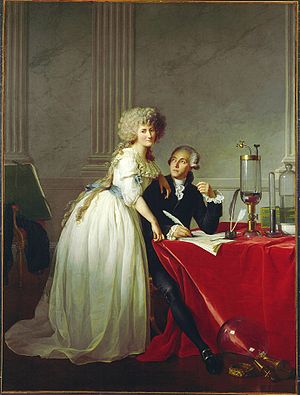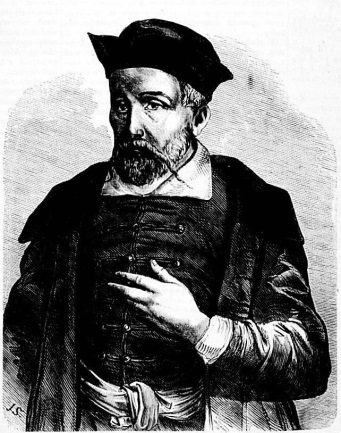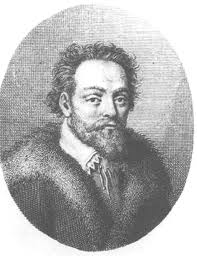David Poole
Michael White
Kansas, United States
Brian Whipp
Powys, Wales
 |
| Jacques-Louis David’s (1788) painting of Marie-Anne and Antoine-Laurent Lavoisier which now hangs in New York’s Metropolitan Museum of Art. Note flasks for collection and analysis of expired gases. |
We live submerged in a sea of life-preserving oxygen. As I sit at my desk, my diaphragm contracts rhythmically, powering a breath every four seconds or so. Each breath is barely perceptible – but for the dust particles – tiny whirling dervishes emblazoned by the low winter’s sun. These inhaled particles will sediment in the airways but each minute several liters of air, over one fifth of it molecular oxygen, some four sextillion molecules, bombard each other to push deep inside my lungs, creating pressure and forcing a quarter of them across the exquisitely thin alveolar blood gas barrier. In a superb synchrony of cardiorespiratory transport that will define my lifespan, they will consort briefly with hemoglobin and flow downstream to soothe my peripheral chemoreceptors. These tiny organs are the watchdogs for blood oxygenation, comforted by its presence, enraged by its absence. Oxygen flows through my body, seven thousand quintillion molecules each minute, fueling every mitochondrial energetic need, keeping organs functioning and my brain focused. When I move my skeletal muscles awake, and the oxygen transport system faithfully accelerates ten-fold or more, ensuring an uninterrupted supply of life’s elixir.
Molecular oxygen appeared on Earth as a metabolic byproduct, some three billion years ago as simple unicellular life harnessed photosynthesis for energy. A death sentence for anaerobes, oxygen nourished evolving multicellular eukaryotes sculpting Earth’s flora and fauna. The Cambrian explosion 542–488 million years ago, was driven by atmospheric oxygen allowing the unprecedented evolution of evermore complex life. As creatures grew in size, atmospheric oxygen traveled further to cellular targets necessitating highly-integrated respiratory organ systems. Across the animal kingdom, evolution has shaped the genome around oxygen’s double-edged sword. Too much is highly toxic, generating reactive oxygen species; too little causes irreparable brain damage. For mammals, the maximal capacity for oxygen transport and use defines athletic potential at one end of the spectrum whilst categorizing the predations of diseases such as heart failure at the other.
Humans have recognized oxygen’s presence and sentinel role in respiration for less than five centuries. In the 18th century Ernst Stahl’s (1659–1734) tenacious phlogiston (Greek for fire) hypothesis obscured the true behavior of oxygen and carbon dioxide. Phlogiston, an imaginary substance, supposedly acted as the mirror image of the oxygen that we know today. It was supposed to be created by combustion instead of being consumed, and when metals were found to gain weight by burning evoked the charming notion that phlogiston had negative weight! Despite the incredulous nature of these claims, removing the manacles of phlogiston and Stahls’s thinking took decades and several truly extraordinary minds.
The discovery of oxygen has been described as “the most important discovery in the history of science”. Science historians have identified at least three key individuals (Lavoisier, Scheele, Priestley) to be credited with oxygen’s discovery in the late 18th century. As befits the intense competition for this supreme accolade, acknowledged suitors died Shakespearean-style deaths or were evicted forcibly from their homeland.
Carl Wilhelm Scheele (1742–1786) was an extraordinarily talented and luckless Swedish chemist who discovered at least seven elements: fluorine, chlorine, barium, manganese, molybdenum, tungsten and nitrogen, and yet received credit for none of them. He synthesized oxygen (which he termed “fire-air”) in 1772 but failed to beat Priestly or Lavoisier to the punch because he delayed until 1777 the publication of “Chemishe Abhandlung von der Luft und dem Feuer”. In 1786 Scheele died in his laboratory, tongue blackened and swollen, his flair for synthesizing poisonous compounds clashing fatally with his bizarre habit of tasting them.
Joseph Priestley (1733–1804) was an English theologian, founder of the Unitarian church, natural philosopher, chemist, educator, and political theorist, who more than doubled the gases known to humankind (he added to the lexicon nitrous oxide (laughing gas), carbon monoxide, and sulfur dioxide). He also developed the carbonation process that produces what we call fizzy drinks and he charmingly termed “windy water.” Priestley noted that after a candle extinguished itself in a sealed container the gas would not support the life of a mouse without regeneration by green plants. He produced oxygen, which he called dephlogisticated air, by heating mercury oxide, and he promptly traveled to France to show Lavoisier the astonishing brightness of the flame it supported. In 1774 he published his paper “Experimental observations on different kinds of air”. In 1791 after his home, laboratory, and church were burned by a mob Priestley fled Britain for Pennsylvania where he set up America’s first scientific laboratory.
Antoine-Laurent de Lavoisier (1743–1794), the brilliant French chemist and polymath, was elected to the French Academie des Sciences at only twenty-five years of age. Together with his wife, Marie-Anne, Lavoisier and mathematician Pierre Simon Laplace (1749–1827) used essential information from Priestley, Scheele, and others, to determine that the burning of coal used oxygen to produce energy and carbon dioxide. They discovered that sulphur and phosphorous increased their weight by burning through combination with oxygen and not by the loss of an ephemeral substance with negative weight. This in itself lead to the novel idea of the conservation of mass and vanquished the phlogiston theory, a finding that revolutionized chemistry and physiology and led Lazaro Spellanzani (1729–1799) to propose what we know today; the peripheral tissues—not the lungs or blood—are the site of respiration.
Unfortunately Lavoisier’s was not the only revolution in France at that time and he had amassed multiple strikes against himself. He was nobleman and owned a spectacularly profitable interest (yielding over $20 million per annum in today’s coin) in the despised Ferme Generale (General Farm) which collected taxes from the poor, not the rich. This revenue funded the most sumptuous private laboratory in the world. As commissioner for gunpowder he supervised the construction of a wall surrounding Paris to deter smuggling. This hated structure was the first thing attacked by the much-aggrieved sans-culottes in 1793. Possibly most damning of all, when the young scientist John-Paul Marat submitted a new (and incorrect) theory of combustion to the Academie Royale, Lavoisier was dismissive. Marat never forgave Lavoisier for damaging (ending?) his scientific career. Subsequently, as a leading figure in the National Assembly, Marat denounced Lavoisier with the contemporary sentiment that “The Republic has no use for men of science.”
During the Reign of Terror, and in a speedy trial watched over by Marat’s bust—the provocateur himself having been murdered in his bathtub—Lavoisier was beheaded in the Place de la Republic (now Place de la Concorde), on May 8, 1794 on France’s busiest guillotine. As a final indignity one hundred years after his death the statue erected in Paris to honor him was much admired until a perceptive viewer remarked that it bore no resemblance to Lavoisier. The sculptor subsequently admitted using a “spare” head, from the Marquis of Condorcet, that he had on hand. Alas, nobody really cared, and it remained untouched until melted down for munitions in World War II. By contrast, statues of Scheele and Priestley stand proudly in Köping and Leeds—where Priestley obtained his carbon dioxide supplies from the local brewery. Admirers of Lavoisier must visit David’s beautiful painting of Antoine and Marie-Anne in their sumptuous laboratory that hangs today in New York’s Metropolitan Museum of Art (Figure 1).
Written and verbal history has been lambasted as “a myth generally agreed upon” by Napoleon, reflecting that the historical record is inevitably (re)written by the victors. This explains why history so often has a profound ethnic, racial, or national bias. How else can a continent vibrant with humanity be “discovered” by Columbus? What right did Livingstone have to stumble upon Mosi-oa-Tunya (Makololo for “the smoke that thunders”) and dub it “Victoria Falls” after his regent? What arrogance, what hubris! And so, for Scandinavians Scheele “discovered” oxygen, for the Americans and British it was Priestley, and for the French it was Lavoisier who named oxygen “oxygine” (perhaps incorrectly) for its acid-forming properties and described so beautifully the relationship between oxygen uptake and carbon dioxide production known as the respiratory exchange ratio.
Recently, a time-lapse play “Oxygen” set in Stockholm in the 18th and 21st centuries has held audiences enthralled with Marie-Anne Lavoisier hiding a key letter from Scheele in an attempt to have her husband awarded sole credit for oxygen’s discovery. Four Nobel committee panelists dispute who amongst these three should receive the world’s first “Retro-Nobel Prize” and the audience judges the winner.
 |
 |
 |
| Michael Sendivogius (left), Cornelis Drebbel (middle) and King James I (right) in 1621 watching what may have been the World’s first functional submarine making the passage from Westminster Bridge to Greenwich (von G. W. Tweedale, 1626). |
||
The Franciscan Friar, William of Occam (or Ockam, in Surrey, c. 1287–1347), is remembered for applying his principal of parsimony approach to logical problems known eponymously as Occam’s razor. Legend has William of Occam proving the Earth’s sphericity to religious zealots by pointing out its curved shadow on the moon. If Occam’s razor is applied to the question of whether Lavoisier, Scheele, or Priestley, or possibly all three, should be credited with oxygen’s discovery, the result is quite clear—none of them: oxygen was discovered and isolated (but not named as such) more than a century before their births.
Throughout the Medieval period and beyond the practice of alchemy revolved around the belief that transmutation of lesser or “base” metals such as lead produced gold. Like money-lending, the alchemist’s calling was reviled and until the late 20th century any scholar daring to give alchemists credence would “become tinctured with the kind of lunacy they set out to describe”. This dogma was not dispelled until the 1980s, when revisionist scholars began deciphering alchemical texts, an undertaking that presented a considerable challenge given the secretive paranoia of their trade. For instance, the “cold dragon” who “creeps in and out of the caves” was alchemist lingo for saltpetre (potassium nitrate, KNO3–), found on cave walls, “tasting” cool to the tongue and highly explosive. The Polish alchemist Michael Sendivogius (Michał Sędziwój, 1566–1636, Figure 2, left) spent much of his time and efforts digging saltpetre out of public urinals, presumably because of a lack of convenient caves rather than for the taste.
When potassium nitrate is heated according to: 2KNO3 → 2 KNO2 + O2, molecular oxygen is produced, which Sendivogius collected and used in his experiments. This process was widely known in 17th century Europe as evidenced by the use of oxygen by the secretive and pioneering Dutch engineer and scientist Cornelis Jacobszoon Drebbel (1572–1633, Figure 2, center). Drebbel recognized that air was a mixture of gases and, possibly after a lesson from Sendivogius himself, purified what he called the ”spirituous part of it that makes it fit for respiration”. In 1621 Drebbel demonstrated to King James I (1566–1625), who took a keen interest in literature, theology, witch hunting, and especially science, that his “liquor” (presumably oxygen) could sustain up to twelve men in a submarine for 1–3 hours as they rowed some seven miles from Westminster to Greenwich down the River Thames (Figure 2, right). James I’s affinity for science was understandable, given that his personal physician was William Harvey who in 1628 was to publish “de motu cordis et sanguines”.
Thus, well before Priestley, Sheele and Lavoisier’s “discovery” and the naming of oxygen in about 1774, the gas had been purified and used to sustain human life and exercise by an extraordinary Polish alchemist and a Dutch engineer. The great Sir Isaac Newton’s words “If I have seen further than others, it is because I have stood on the shoulders of giants” describes well the (overlooked) statures of Sendivogius and Drebbel, who had shoulders broad enough for Lavoisier, Scheele, and Priestley to stand on. Although each of these scientists made discoveries fundamental to the chemistry of respiration, oxygen was not one of them.
References
- Astrup P and Severinghaus JW. Blood gas transport and analysis. In: West JB. Respiratory physiology: People and ideas. American Physiological Society, Oxford, 1996, pp. 75–107.
- Brock WH. The Norton history of chemistry. W.W. Norton & Co., New York, 1993, pp. 95–96.
- Butterfield H. The origins of modern science: 1300-1800. Free Press, 1957.
- Forster RE II. Transfer of gas by diffusion and chemical reaction in pulmonary capillaries. In: West JB. Respiratory physiology: People and ideas. American Physiological Society, Oxford, 1996, pp. 49–74.
- Harvey W. Exercitatio anatomica de motu cordis et sanguinis in animalibus, 1628.
- Lavoisier AL. Oevres de Lavoisier. Imprimerie Imperiale, Paris, 1862–1893 (1784).
- McGough R. Oxygen. In: Collected poems. Viking, London, 2003. P. 371.
-
Poole DC & Jones AM. Oxygen uptake kinetics. Compr. Physiol. 2: 1–64, 2012.
-
Priestley J. Experiments and Observations on Different Kinds of Air. Bowyer W and Nichols J, London, 1774.
-
Principe LM. The secrets of alchemy. University of Chicago Press, Chicago, 2012.
- Severinghaus JW. Fire-air and dephlogistication. Revisionisms of oxygen’s discovery. Adv Exp Med Biol. 543: 7–19, 2003.
- Szydlo Z. Water which does not wet hands. The alchemy of Michael Sendivogius. Institute for the History of Science, Polish Academy of Sciences, Warsaw, 1994.
- Taylor CT & McElwain JC. Ancient atmospheres and the evolution of oxygen sensing via the hypoxia-inducible factor in metazoans. Physiology 25: 272–9, 2010.
- West JB. Respiratory physiology: People and ideas. American Physiological Society, Oxford, 1996.
- White M. Rivals: Conflict as the fuel of science. Vintage, London, 2001.
DAVID C. POOLE, PhD, DSc, is recognized internationally for his contributions to the fields of pulmonary gas exchange and systemic oxygen transport especially as regards vascular and microcirculatory control. His current research examines the mechanisms for vascular dysfunction in chronic heart failure and diabetes and the development of novel strategies for improving muscle function and quality of life. His research laboratory is supported by the National Institutes of Health and the American Heart Association.
, BA, earned degrees in Economics and Spanish Literature and Culture with High Distinction from the University of Virginia. Currently, he is a fourth-year DVM candidate at the College of Veterinary Medicine at Kansas State University. His interests include cardiopulmonary physiology, orthopedic surgery, and veterinary ethics. A recipient of the Veterinary Health Professions Scholarship Program, he will join the US Army Veterinary Corps upon graduation.
, PhD, DSc, (1937–2011) was a Welshman and a noted athlete (decathlon, squash, table tennis) from Tredegar who became an influential pioneer and Master—scientist, teacher, and philosopher—in the fields of respiratory and exercise physiology. He could hold listeners spellbound by his knowledge of science, art, music, literature, history and by his command of language in crafting the perfect, definitive phrase. His discoveries now form the basis for diagnosis, prognosis and integrative physiological assessments used throughout the world in medicine, exercise physiology and sport.
The following Arabic proverb conveys a measure of Professor Whipp’s philosophy:
He who knows not and knows not that he knows not—a fool, shun him.
He who knows not and knows that he knows not—a student, teach him.
He who knows and knows not that he knows—a poet, watch him.
He who knows and knows that he knows—a Master, follow him.
Brian Whipp truly was a “Master”.
Highlighted in Frontispiece Winter 2015 – Volume 7, Issue 1
Winter 2015 | Sections | Science

Leave a Reply